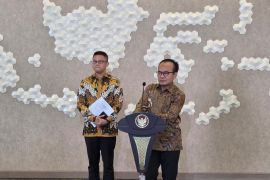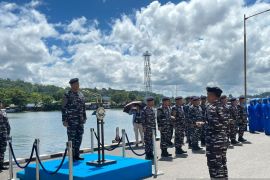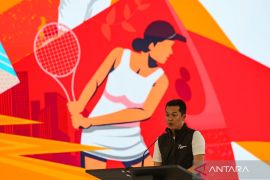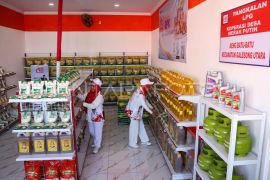The role of Asian marine sector in the future will have significant contribution to the environment, energy, food, and other environmental services in supporting food security and economic growth. Asian oceans is also has the role to slow down global warming and climate change, as well as for physical variability that has wide impact on all life
aspects. Non-biological resources from Asian region have provided supplies and economic prospects such as sea minerals, gas, and energy. Meanwhile, abundant marine biological resources and its high level of biodiversity,both capture fisheries and aquaculture, contribute to the community’s food supply.
For enriching the outcomes of the Asia conference, this meeting builds on 3 pararel events namely The Indian Ocean and Pacific Conference (IOPAC), the Marine and Fisheries Investment Forum (MFIF) , and ACOFB, which are highly important forums for Asian countries. Considering that the outcome will be an Action Plan and commitment for the countries to deal with marine-based food security issue through blue growth framework. The result of this conference will further develop a Road Map which is significant to the region’s future. It will furthermore be brought to the Global Ocean Action Summit ( 9-13 September 2013), the Hague-Netherlands. As Mr. Sharif asserted.
Indonesia has played a major role in food security issue. The successful The World Ocean Conference 2009 in Indonesia has redefined the critical role of oceans to respond to climate change and food security. Therefore, through this Asia Conference Indonesia takes the initiative to pursue world’s ocean vision into action that would be
Asia’s road map to blue growth. Combining oceans’ roles, blue growth and food security, the conference has become the benchmark for policy makers, international monetary institutions, investors, scholars, NGOs and private sectors to contribute and establish partnerships. “ACOFB and IOPAC are believed to give maximum output. Support from scientists will help creating blue investment to sustain blue growth which is the input of fisheries products to maintain food security.†He said.
Blue Investment Economy
According to Mr. Sharif, the result of ACOFB 2013 is expected to be in accordance with the commitment of Indonesian government in managing marine and fisheries sector. The shift to new paradigm, which is blue growth-based for marine and fisheries resources, shows that Indonesia acknowledges the significance of oceans as the main driving force for development. It is primarily intended to support national economic growth, poverty alleviations, reduction of carbon emissions, countermeasures for illegal fishing (IUU), optimization of the function of environmental services, and acceleration of industrialization within the blue economy framework. “The development
of marine affairs and fisheries in Indonesia is essentially based on blue economy concept. This is in line with Mr. President’s pronouncement on Plenary Session United National Conference on Sustainable Development on June 2012 in Rio de Janeiro, that blue economy is our next deadline in which by implementing it we will maximize the environmental services and sustainable economic values,†he explained.
The implementation of blue economy concept in industrialization of marine and fisheries is crucial. To boost marine and fisheries investment, Indonesian government has enacted policies to create conducive climate for investment that attracts new investor and also to facilitate mediation, promotion and cutting restrictions to investors. These policies are predominantly to assist enterprises and investors creating investment in marine and fisheries sector. By providing mediation, facilitation, as well as incentives and promoting investment opportunity, it will give a complete picture on how marine and fisheries investment opportunity in Indonesia is still widely opened. “Through these ACOFB and MFIF, it is also expected to affect the fulfillment of marine and fisheries investment that supports blue economy concept,†Mr. Sharif uttered.
In addition, this industry is getting more strategic, knowing that it has close linkages with other sectors. Indonesian marine and fisheries sector is a potential motor to shove local and national economy. “Asserting the success of marine and fisheries industrialization based on blue economy framework, the goal of social welfare and food security can be well achieved,†said Mr. Sharif.
For further information, please contact Anang Noegroho, Acting Director of Data Statistics and Information Center, the Ministry of Marine Affairs and Fisheries (Mobile. 08118062444)
INDONESIA FISHERIES DATA
Fish Consumption Level
Dietary pattern: 31.4 kg per capita per year
Fisheries Product contributes to 66% of the total of animal products
Consumption level:
Indonesia year 2012: 33.8 kg per capita per year
Indonesia year 2011: 32.2 kg per capita per year
Asia year 2011: 20.9 kg per capita per year
Domestic Fishery Productions
Indonesia year 2012: 15.26 million tons
Capture fishery production: 5.81 million tons
Aquaculture fishery production: 9.45 million tons
Indonesia year 2011: 12.39 million tons
Capture fishery production: 5.41 juta ton
Aquaculture production: 6.98 million tons
Domestic Processed Fishery Products Volume
Processed products volume year 2012: 4.83 million tons
Processed products volume year 2011: 4.5 million tons
Trade Balance
Exports Fishery Product
Indonesia year 2012 US$ 3.9 billion
Indonesia year 2011 US$ 3.5 billion
Asia year 2011 US$ 49.7 billion (39 % of the world’s total export)
Imports Fishery Product
Indonesia year 2012 US$ 412.3 million
Indonesia year 2011 US$ 492.5 million
Asia year 2011 US$ 42.5 million
Work force , Fishery Processing Unit and Investment in 2012
Work force dealing with fish processing and distribution are 6.3 million people
Fishery Processing Unit is 619 units
Investment ammounting to Rp.2.067 trilyun = USD 206 million
Editor: PR Wire
Copyright © ANTARA 2013










